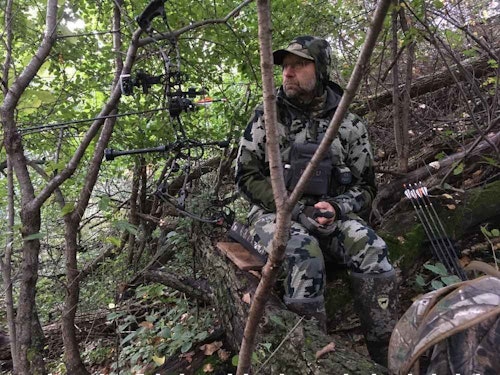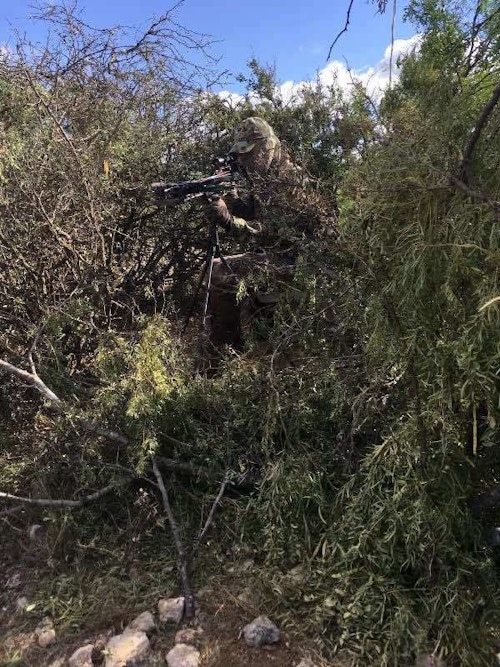
Fresh rubs tipped off the author and his dad that this public land swamp would be an excellent spot to ambush a buck. Rather than jump through the hoops of placing a hang-on stand in a tamarack tree, the author quickly carved out a ground ambush near a toppled tree. The author asked his dad to stand by the tree so you could see him in the background of this photo. When his dad sits among the toppled tree's branches, he disappears.
Just as NFL offenses typically do better when featuring a balanced pass vs. run attack, whitetail hunters shouldn’t abandon their “ground game” and spend every minute a treestand. Sure, treestands are effective, but there’s also a time and place for hunting from the ground.
The advantages of hunting from an elevated position are well known. It’s easier to avoid a whitetail’s sense of smell, and if you have decent cover in the tree then you can avoid a deer’s eyesight (provided you don’t move at the wrong time).
But let’s not forget about the disadvantages. On public land, a ladder stand or hang-on portable that is left in the field tips off other hunters to your whitetail game plan. In fact, on the public lands I bowhunt, treestands left on public land are first come, first serve. This means that even though you invested the time and effort in placing the stand, if another hunter beats you to the spot on any given day, then he or she is 100 percent within their rights to climb into “your stand” and hunt. You won’t like it, but as my dad used to say, “Fair is where you go to show pigs.” Another disadvantage is the noise caused by hauling in a treestand and then clearing shooting lanes (where legal).
I’m sure some readers are thinking that saddles offer the best of both worlds; you can hunt from above and do so without alerting area whitetails. Maybe, maybe not. It all depends on the forest, and specifically the types of trees and cover present.
In the places I bowhunt in Minnesota, South Dakota and Wisconsin, the chance of climbing a desired tree and then bowhunting immediately (what the YouTubers like to call a “hang and hunt”) is very low. Why? Because even though you could climb 12 to 22 feet quietly and settle into your saddle, the cover in your saddle tree plus the cover in neighboring trees is too thick for a clear shot. I’m not a fan of bowhunters who say “I think I can sneak one through” when it comes to firing an arrow at an animal. We aren’t plunking 3-D targets. Thinking you can sneak one through isn’t good enough. The shot must be clear or it’s irresponsible to release an arrow. Period.

I like to pursue whitetails in swamps, especially on public land, and much of the time treestands aren’t an option because there aren’t any suitable treestand trees. And even if I did climb a tree, I’d be able to see less from above than I could from the ground. In these cases, it’s a no-brainer to bowhunt from the ground.
I’m not talking about hauling in a pop-up ground blind. Not only will other deer hunters see it if you leave it in the field, but whitetails will likely avoid it for weeks, too. Instead, I use existing cover to carve out an ambush. Note, I didn’t write “build a blind.” Occasionally I will haul in dead logs and branches to construct an ambush, but such a blind could be discovered by other public land hunters.
To avoid this problem, I find a pocket of thick cover/brush downwind of a likely deer trail or hot scrape and carve out an ambush. (Check your local laws regarding cutting shooting lanes on public land.) Clear out a big enough area to sit on a stool and draw your bow or have clearance for crossbow limbs. For shooting lanes, if it’s illegal to cut brush, grasses and cattails on public land, then do your best to flatten it by walking on it, or carry twine to tie saplings out of the way. You want a clear path for your arrow, but don’t make a shooting lane so wide that deer or other hunters will discover your ambush.

The next time you find a hotspot when whitetail scouting or hunting, don’t automatically think “treestand.” Look at the area. Is a treestand the best option, or would it be faster, easier and less intrusive to carve out a ground ambush? If I’ve learned anything during my 45 years of pursuing whitetails, it’s that many times a ground ambush is the smartest game plan.






